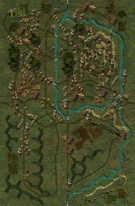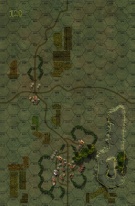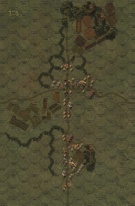| Author |
NBGB
|
| Method |
Solo |
| Victor |
Britain, France |
| Play Date |
2019-10-18 |
| Language |
English |
| Scenario |
RtDk029
|
I was looking for a scenario that had a lot of units and some armor. Road to Dunkirk does not have the giant tank battles you see in other PG games. This scenario has a little bit of everything.
The Germans are trying to simultaneously hold a road across 2 boards, hold 2 town hexes at the same time,(one on aforementioned road and the other all the way across the board), eliminate 30+ steps, not lose more than 29 steps, and maybe move units off the north (opposite) edge of the field. They need to achieve 3 of these objectives to get even a minor victory.
To do this, they face a combined British and French force. The French have some excellent armor (1 company S35 plus 1ZT2), some 25mm Portee’s and minimal infantry. They also have off board artillery 4x15 strength that can only be used on a die roll of 1 or 2. One chance per turn and counts as an activation. (Blech). The Brits field a large infantry force, about a brigade, plus a couple of 25 lb’ers. They also get some battalion size tank reinforcements on turn 9. Both British and French have average morale (8/6).
The Germans have about 2 brigades worth of troops with a couple battalions worth of armor. (Half of it PZ1 and PZ2 which are bad). They also have devastating artillery.
The terrain is flat (slopes, hills ignored) with one major river all the way across the Southern edge of the field. This river splits in 2 for a ways. This complicate setup as all bridges are blown. That means the Germans would have to make 2 river crossings in one area if they choose. One can be uncontested, but it still takes time.
Before setup you need to take in to account the lousy visibility that starts out at 4 hexes and can go up or down at the end of each ACTION segment with a dice roll. Throw in the random events table used in this game and there is a LOT going on here for a solo scenario.
On each turn you have the normal dice rolling, plus a possible random event, plus a roll after each action segment, plus fog of war when applicable.
Sorry for the long opening, but this one has a lot of moving parts.
The French set up to guard the western third of the river plus a few companies to offer resistance in the rear at one of the town control hexes. The British take the rest of the River to the east edge as they’re armor reinforcements come in from the east edge. All units are dug in or in the many town hexes.
The Germans can set up South of the river or enter in the west edge Not much transport for the infantry so I had the Germans set up South of the river except the armor, the 88, and a few companies of infantry that could be transported.
The idea was that there would be 2 crossings set up, one in the French controlled area and 1 diversionary crossing set up way east on the British left. The armor would swoop in from the West and grab the town hexes and roll up the rear.
The Germans swooped in from the West and took the first town hex early. They also started the diversionary crossing right away. The Brits move up on the German bridgehead to spot for artillery and block. This started a half game long crossing attempt as both sides pounded each other with artillery and added in a lot of gunfire. This slog went on all game as the Germans were never able to break out. They did manage to finally get everyone across and occupy a sizable British contingent.
The main crossings took a while for the uncontested crossing and the second ones were successful for a while and then repelled stranding a battalion of units across the river. They fought hard until the end, but it was a standoff. The French were not strong enough on their own, but Brits from center relocated about a battalion and reinforced the French.
Then there were the armor battles. The Germans were not able to penetrate the Matilda 2’s armor unless they were at point blank range and using a crossfire with a Panzer 4D. This made them susceptible to CA attacks from the Matilda 1’s.
Same for the S35 platoon. They were never taken out. All these battles within the battle and with FOW it was difficult to keep momentum going .
The Allies got a minor victory as the Germans could not hold both town hexes, clear the road and manage not to lose 29 steps. Light tank armor with tanks counting double exacerbated this.
|


 RtDk028
RtDk028 


































